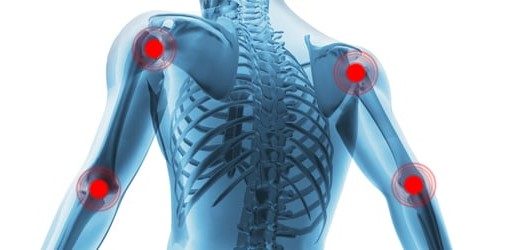Fibromyalgia and exercise
Fibromyalgia syndrome (FMS) is a musculoskeletal pain and fatigue disorder resulting in pain within the fibrous tissues. It's a rheumatic condition characterised by stiffness and localised tender points at specific points in the body with pressure causing a heightened pain response. fibro (fibrous tissue) my (muscle) algia (pain).
Around 90% of sufferers are female with the majority in their 40’s and 50’s. Current estimates suggest it affects around 2-5% of the population with 92%+ being caucasian.
Diagnosis


The criteria for the diagnosis of Fibromyalgia is widespread pain and chronic symptoms lasting longer than 3 months, in combination with tenderness in 11 or more of the 18 specific, predetermined tender points. There are currently no blood tests or x-rays available that demonstrate any abnormalities associated with FMS.
The intensity of the pain tends to fluctuate and there is no known cure for the condition. There are however, a number of management strategies that can relieve symptoms, not least of which is exercise.

Symptoms
PAIN
The pain of fibromyalgia can manifest itself in many ways. Sufferers often describe the chronic pain as being ‘all over’ and use adjectives such stabbing, throbbing, aching, shooting and burning. For some, the mornings feel worse as the stiffness takes longer to subside after sleeping. Pain is more likely in muscle groups that are used repetitively and painful areas often include all quadrants of the body, particularly the neck, upper and lower back and the shoulders.
FATIGUE
Levels of fatigue can vary greatly with some finding themselves incapacitated, whilst others are only affected mildly. It can interfere with daily activities and a lack of energy can create sedentary behaviours resulting in a lack of exercise, in turn generating a cycle that makes the condition worse. ‘Brain fatigue and brain fog’ are often cited, experiencing difficulty in concentrating and feeling drained of energy.
SLEEP DISORDER
The alpha-EEG anomaly sleep disorder is often associated with FMS. Falling asleep isn’t a problem, but deep sleep is constantly disturbed by bursts of brain activity. This contributes to already high levels of fatigue as deep sleep deprivation accumulates.
TMJD - TEMPORO-MANDIBULAR JOINT DYSFUNCTION SYNDROME
A high percentage of fibromyalgia patients experience intermittent jaw and facial pain which are directly related to the soft tissue surrounding the jaw.
CHRONIC HEADACHES
Tension headaches and migraines can occur on a regular basis.

Misdiagnosis
Fibromyalgia is often misdiagnosed as the symptoms can mimic or overlap with a number of other conditions. It's imperative that a Doctor rules out other possible illnesses and disorders before diagnosing a patient with fibromyalgia.

These include:
Chronic fatigue syndrome (ME/CFS)
Hypothyroidism
Lupus
Multiple sclerosis
Osteoarthritis
Rheumatoid arthritis
Depression
Lyme disease
Sleep apnea
Irritable bowel syndrome
Raynaud's syndrome
It is feasible that other musculoskeletal disorders such as joint hypermobility syndrome can be misdiagnosed as fibromyalgia. Excessive and repeated microtrauma to the muscles and ligaments suffered by those with JHS, EDS-III and other hypermobility spectrum disorders can result in over activation of the pain receptors around the joints, leading to pain hypersensitivity (hyperalgesia). This can present as both acute and chronic widespread or regional pain. Exercise treatments must be adapted for both cases to avoid injury and additional pain.
Exercise as treatment
Medication and cognitive behavioural therapy are among the most common treatment options for fybromyalgia patients. Exercise and myofascial release play a vital role alongside these strategies.
Widespread multisite muscle pain and increased fatigue can limit activity options for FMS patients, negatively affecting the willingness to exercise, resulting in muscle atrophy and weakness and cardiovascular de-conditioning. Thus a viscous cycle begins making the symptoms worse. Evidence increasingly shows that exercise is vital in management and recovery of FMS and considered to be a highly effective treatment in relieving symptoms. As with all cases exercise can lower stress; improve sleeping patterns; produce pain killing endorphins; increase muscle tone; improve cardiovascular capacity therefore making everyday tasks easier; improve flexibility thereby reducing stiffness; reduce the likelihood of depression; increase metabolism and help manage body weight.
Although fibromyalgia is painful, it does not cripple, damage tissue or shorten life expectancy so exercising at the right pace is of huge benefit.
It’s important to progress the level and type of exercise dependent on an individual’s symptoms and severity which fluctuate greatly with FMS. Because of its unpredictability, what seemed relatively easy on one day can prove to be an almighty challenge on another. Fatigue is often the most limiting factor. Steady progression is key as muscle fibres take longer to recover.
Non-impact areobic and body weight resistance exercises are the best options
Aerobic
Walking, cycling and swimming are recommended. They are low impact and as such there is no pounding through the joints that can cause additional pain at the tender points. All help maintain and improve cardiovascular fitness and muscle tone.
This could start with as little as 5 minutes per day during severe flare ups, gradually increasing to at least 30 minutes up to 5 times per week. As fitness levels improve and symptoms become more manageable the intensity can be adapted for greater fitness gains.
Resistance
For resistance training, body weight exercises and utilising therabands rather than weights is advisable. The load is managed whilst minimising the risk of injury. Resistance exercise will increase muscular strength and endurance. Incorporating a corrective exercise programme can improve posture, alleviating the additional pain caused by poor movement patterns.
Stretching and myofascial release should also be included in the exercise programme as an effective pain management protocol.
Taking control of your condition
Because there is no cure for fibromyalgia at this time, management is the solution. The trainer will respect the limitations of your body, but not be bound by them and the patient must take the same approach. Due to the unpredictable nature of the condition it can be incredibly frustrating. Progress can be slow and setbacks will occur, but self-management techniques - which include an exercise programme - will improve quality of life and empower every sufferer to take control of their condition to the best of their ability.
Our clients say. . .
"It has been a pleasure working with Claudine over the last few months in our 1-2-1 personal training sessions. I am glad I chose to work with Claudine, as I have chronic pain/fibromyalgia, hypermobility, and joint problems. She is very knowledgeable, and experienced with working with people undergoing rehab. Claudine understands the importance of posture and muscular balance, so I could continue with my recovery and reduce the risk of injury/relapse after being released from my physiotherapist. We have made a lot of progress with respect to addressing my muscular imbalances, stability, and balance issues and I have only felt better as a result. As I continue with my recovery, I feel that the supervision and programming that Claudine has provided has helped me significantly."
T.Algusane
